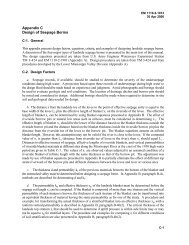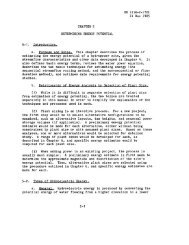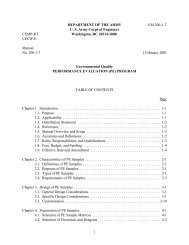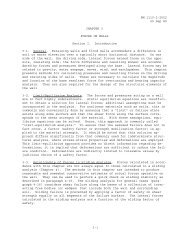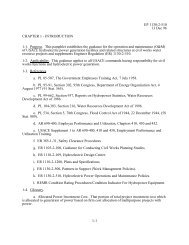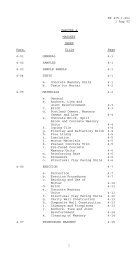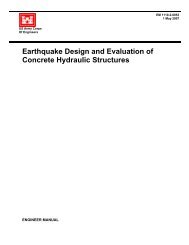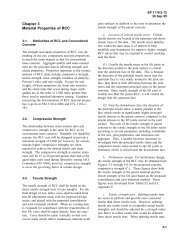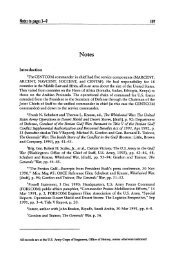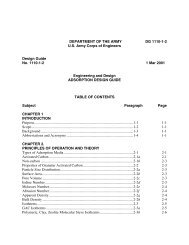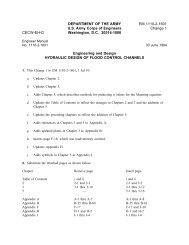em2901.chp:Corel VENTURA - Publications, US Army Corps of ...
em2901.chp:Corel VENTURA - Publications, US Army Corps of ...
em2901.chp:Corel VENTURA - Publications, US Army Corps of ...
Create successful ePaper yourself
Turn your PDF publications into a flip-book with our unique Google optimized e-Paper software.
EM 1110-2-2702<br />
1 Jan 00<br />
support should be assumed and where spherical bearings are used at the trunnion, a pinned support should<br />
be assumed.<br />
(b) Loads. The girders support the skin plate assembly and loads to the girder are applied through the<br />
ribs. Therefore, for each load combination, girder loading is based on reaction forces from the rib model.<br />
A uniformly distributed load equivalent to the rib reactions distributed over each tributary area is applied<br />
along the length <strong>of</strong> the girder. This distributed load does not require a load factor, since the rib reactions<br />
are a function <strong>of</strong> factored loads. For gates with wire rope hoists, a concentrated load equal to the reaction<br />
for the rib that supports the wire rope should be applied to the girder at the corresponding rib location. The<br />
concentrated load is due to a distributed rib load equal to 1.2Q/r for load cases 4 and 5 or RQ/r for load<br />
cases 2 and 3 (RQ is determined by the end frame model described in paragraph 3-5.a(3)). For hydraulic<br />
hoists, the cylinder force load should be applied at the cylinder connection location (for most cases on the<br />
strut near the girder). This force is equal to 1.2Q for load cases 1, 4, and 5 or the cylinder force as<br />
determined by the end frame model analysis for load cases 2 and 3. All loads described in paragraph 3-4.b<br />
affect the girder frame member forces since components <strong>of</strong> each load are transferred through the ribs. It is<br />
assumed that girder lateral bracing resists girder torsional forces that are caused by gravity loads.<br />
(c) Results. The girder frame analysis results include all design forces and deflections for the girder,<br />
flexural design forces about strong axis <strong>of</strong> the struts, and reactions that simulate lateral thrust Rz into the<br />
pier and moment at the trunnion My (Figure 3-12). The lateral thrust force Rz induces friction forces that<br />
are a component <strong>of</strong> trunnion friction moment Ft as discussed in paragraph 3-4.b(1)(f). The effect <strong>of</strong> Rz on<br />
FT should be considered in the analysis <strong>of</strong> the end frame model. For gates with parallel end frames, the<br />
effect <strong>of</strong> Rz may be negligible. However, Rz is more significant for gates with inclined end frames, since Rz<br />
includes a component <strong>of</strong> the strut axial loads.<br />
(3) End frame model. The analytical model for the end frame consists <strong>of</strong> elements to simulate struts<br />
and strut bracing, girders (webs), girder lateral bracing, and the skin plate assembly (Figure 3-13). Struts<br />
are modeled with frame elements, and bracing members are modeled with either frame or truss elements to<br />
be consistent with connection details. The elements that represent the skin plate assembly and girder webs<br />
are included in the model only to transfer loads and to maintain correct geometry. These elements should<br />
be relatively stiff compared to other elements. The girder members should be simulated by truss elements<br />
so the girder lateral bracing elements resist all forces transverse to the girder. (This will ensure that<br />
bracing is proportioned so that girder torsion is limited.) The assumed boundary conditions, loading, and<br />
model geometry are shown by Figure 3-13 for: a) gate closed (load case 1); b) gate operating with wire<br />
rope hoist (load cases 2 and 3); c) gate operating with hydraulic cylinder hoist (load cases 2 and 3); and<br />
d) gate jammed (load case 4) or raised to stops (load case 5). Boundary conditions and loading described<br />
in the following paragraphs are based on assumptions discussed in paragraph 3-4.b(2). The purpose <strong>of</strong> the<br />
end frame model is: a) to determine the sill reaction load RS, operating machinery reaction load RQ, and<br />
trunnion reaction R; and b) to determine end frame member design forces.<br />
(a) Boundary conditions. For each model described by Figure 3-13, the trunnion is modeled as a pin<br />
free to rotate with no translation. For the gate-closed case, the boundary conditions for gates with wire<br />
rope or hydraulic hoists are identical as shown by Figure 3-13a. The gate is supported by the trunnion<br />
(modeled as a pin) and the sill. The sill boundary condition consists <strong>of</strong> a roller-pin free to translate tangent<br />
to the sill. For a 3-D model, the boundary condition along the sill should resist compression only (i.e.,<br />
allow for deformation near the center <strong>of</strong> a gate that will likely result between the sill and gate bottom).<br />
There is no boundary condition for the hoist; a hoist force is treated as an external load. For gate-operating<br />
cases (Figures 3-13b and 3-13c), the gate is supported by the trunnion (modeled as a pin) and the hoist.<br />
(For this case, the hoist force is a reaction and not a load as discussed in paragraph 3-4.b(2)(f)). For wire<br />
3-26




